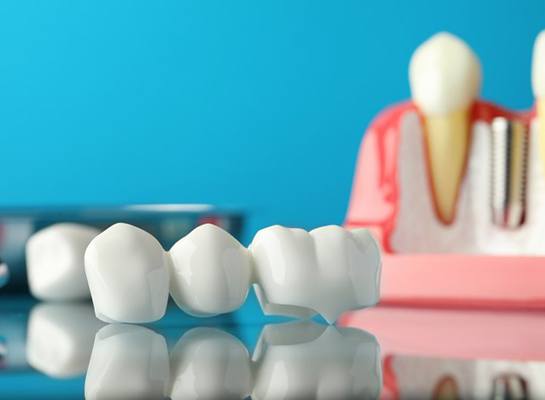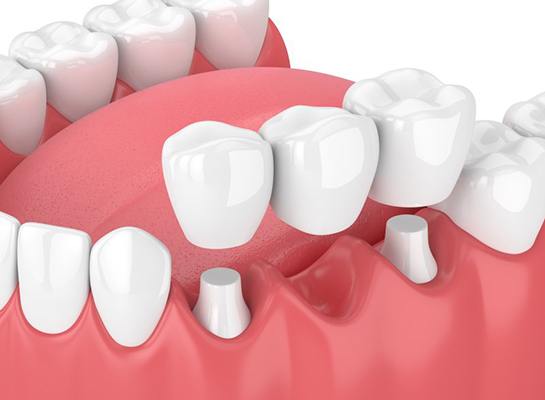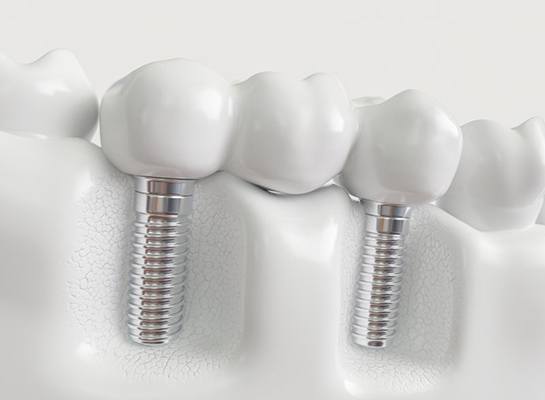Dental Bridges – White Marsh, MD
Bridging the Gaps In Your Smile

If you’re missing one or a few teeth, then you know how difficult it can be to enjoy everyday oral habits, such as eating, talking, and smiling. However, there are several options for those wanting to rebuild their smiles, especially depending on the locations of the lost pearly whites. For those missing one or several teeth in a row, dental bridges in White Marsh might be the solution you’re looking for! With this treatment, you can conveniently replace about three consecutive teeth with a more affordable option so that you can enjoy a full bite again. Keep reading to learn more about dental bridges or give us a call to schedule your consultation.
Why Choose Dental Designs of Maryland for Dental Bridges?
- Natural-Looking & Durable Results
- Completely Personalized Treatment
- Welcomes Dental Insurance & Offers Financing
What is a Dental Bridge?

A dental bridge is a durable and lifelike prosthetic that’s designed to replace one to three missing teeth. This restoration consists of two dental crowns that are placed on either side of the gap via healthy abutment teeth, and then it’s bridged together with pontics (artificial teeth). Once the prosthetic is bonded in place, you’ll be able to enjoy results that seamlessly blend in with the rest of your smile.
Types of Dental Bridges

During your initial consultation, our team will evaluate your oral health, discuss your smile goals, and then work with you to determine which type of dental bridge would be best for you. Here’s what to know about your two treatment options:
Traditional Dental Bridge

Traditional dental bridges are mostly reserved for patients who are missing one or a few missing teeth in a row. This solution only requires that you have healthy teeth on either side of the gap so that the prosthetic can remain stable for as long as possible. In most cases, this option can help replace three or four missing teeth.
Implant Bridge

For implant dental bridges, instead of using dental crowns placed atop natural teeth, our team will embed dental implants into your jawbone to support your prosthetics. Since the metal posts will act like your new tooth roots, this solution can end up replacing four or more missing teeth in a row. Though this option comes with a higher price, it offers the strongest and most stable method.
The Benefits of Getting a Dental Bridge

With dental bridges, you can expect to appreciate a wide range of advantages, including:
- Natural-looking and durable materials
- Simpler maintenance required
- Prevention of dental drifting due to tooth loss
- The bridge can last 15 years (or more with implant bridges) with proper care
Dental Bridges FAQs
Can Dental Bridges Get Cavities?
Dental bridges are artificial and lack enamel, so they can’t get cavities. However, the natural teeth connected to them can.
Note that dental bridges connect to natural teeth (i.e., “abutments”) with dental crowns. As a result, they’re at risk of food debris getting trapped in various places – underneath their pontics, in the space where the crowns meet the gums, etc. Such debris could slowly decay nearby teeth, causing the bridge to become unstable or fail.
Given these points, a bridge patient must practice good oral hygiene. Daily cleaning under and around a dental bridge will keep it safe and secure.
How Many Teeth Can a Dental Bridge Replace?
A dental bridge can replace anywhere from one to four missing adjacent teeth, depending on the patient’s needs. That said, most bridges are only used to replace two teeth at most.
The issue is that a bridge becomes less stable as it extends, so having it replace several teeth is risky. The risk is even greater if the abutments supporting the device aren’t strong or healthy. Should those teeth decay, the connecting bridge could become unstable or fail.
Implant bridges represent an exception to the “two-teeth” rule. As these kinds are anchored with dental implants, they can remain strong and stable even as they “fill” large smile gaps.
Is Getting a Dental Bridge Painful?
Fortunately, the process of getting a dental bridge isn’t painful. The treating dentist takes precautions when performing this work.
Indeed, the dentist will numb your teeth before “preparing” them for your bridge. All they need to do is apply some topical anesthetic to the relevant parts of your mouth. Once this medicine “kicks in,” your smile won’t feel any discomfort as the dentist performs treatment.
With all that said, the connecting teeth may feel sensitive for a few days after treatment. You can manage this temporary soreness by taking over-the-counter medicines.
Do Dental Bridges Feel Natural?
Within a few days of its placement, your dental bridge should feel quite natural to you. It won’t cause any “odd” or unpleasant sensations in your mouth.
This naturalness is partly a result of the treatment materials. Since a dental bridge uses smooth and durable porcelain, eating with it shouldn’t feel strange. It’ll be able to stand up to everyday chewing forces just fine.
At the same time, remember that a dental bridge is tailored to you. The final device is modeled after impressions of your teeth, so it shouldn’t feel awkward or noticeable. You may even forget that you lost any teeth in the first place!

